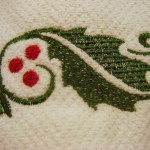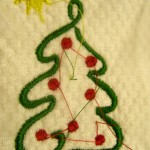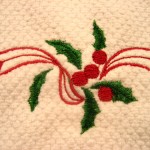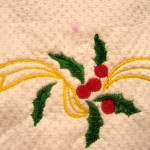We just got a new BabyLock Ellure Plus embroidery (as well as straight) sewing machine. It’s pretty slick. Lauren decided to make some dish towels with seasonal designs as gifts as a first project (to be delivered 2 days after we got the machine!). We learned a lot. (We’ll learn even more when we take the classes in a couple of weeks!)
We went with a water-soluble stabilizer since the backs of the towels would be exposed and visible stabilizer is pretty tacky. It’s amazing – it just disappears under running water and a little rubbing. (A week ago I didn’t even know what stabilizer was!)
The first try was a design we’d downloaded (and converted from Pfaff .PCS to Brother/BabyLock .PES format with some free software from Pulse Microsystems). It came out sort of OK, but since the towels had some pile (they’re not terry, but not just a plain woven fabric), bit of the nap leaked out between stitches. We didn’t use a “topper” – stabilizer on the top of the fabric, designed to prevent just such leaks. That was educational. We used a topper with all the others, and never saw that problem again. The tree design was downloaded, and the holly/ribbon design is built into the machine. The various parts in the same color are usually done in one run – which means undesired threads between them must be manually trimmed away. Interesting task – at least the first few times. We soon got bolder and threaded a different color than the screen said. It may be smart, but it’s color blind, and we got away with it! Here are closeups of the designs as stitched on the towels, plus a shot of the final product.
- First try – needs topper!
- Tree before trimming threads
- Red ribbon
- Used yellow thread for one part
- Ready to go!
Many of the designs we found on the internet cleverly just fit within the limits of a 4″x4″ hoop – an industry standard. (Of course the Ellure Plus also supports a 5×7 hoop, in case we need bigger.)
There are huge piles of both art and science in this new hobby. Art not only in the obvious artistic sense, but in the ever-present task of selecting the best type (or types!) of stabilizer, how many layers, what mix of materials, etc. Whew! And science in the stitch instructions. Resizing a design isn’t like resizing a jpeg. If the image gets bigger, you really need more stitches to fill an area. I suspect there are good similarities between the software that “digitizes” (“punches” is the buzzverb) an image into stitch instructions and the software that creates the instructions for the X-Y table of a 3-D printer like a MakerBot. Commercial software for this is quite expensive, so I have an interesting road ahead looking into open source stuff.
I’m sure there’s much more to follow!





